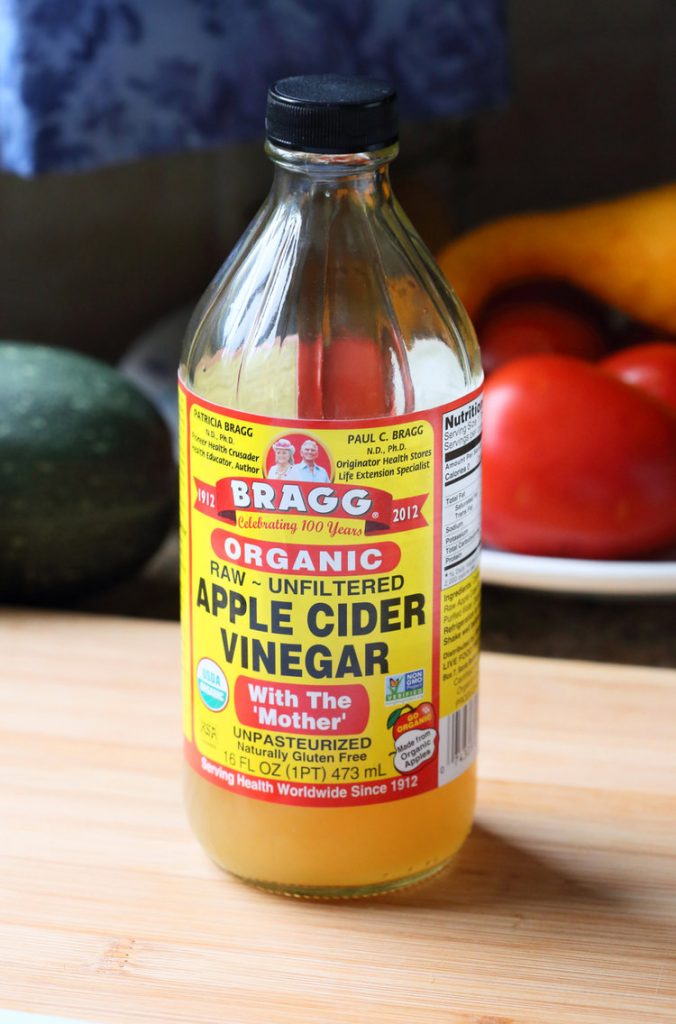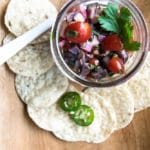
Here’s the southern girl coming out of me again – this time, let’s talk how to cook collard greens (brassica oleracea). If that doesn’t instantly spark those southern soul food vibes, I don’t know what would.
Even though they’re just a simple side dish, collard greens have a way of really taking me back to my southern roots of enjoying amazing food around a big table with family.
Here in Colorado, collard greens aren’t really a thing. I couldn’t tell you one restaurant (other than Cracker Barrel in the city, maybe) that has collard greens on the menu. If I mention them in conversation, people always look at me odd and start questioning me on what they’ve been missing out on.
Thankfully, my high elevation of 7,680 feet with cool nights lend to a perfect climate for growing brassicas like collard greens.
Growing Collard Greens

More traditionally referred to as “collards” in the south, collard greens are super easy to grow and are mostly pest resistant. I grew 6 collard plants this year and have cut away from them on a weekly basis to make a side dish to salmon, steak, and chicken.
They continue to produce and grow strong and healthy. Some of the leaves get aphids and little black flies, but not usually the entire plant – just a leaf or two per plant. Try this garlic spray for better pest management in the garden.
To find seeds, it’s best to find them closer to the area you’ll be growing. For me, that would be to save seeds from my existing plants, find a neighbor that is growing a plant I want to grow and ask for seeds from them, or find a seed store within the state of Colorado. But, when none of those are an option, you can buy open-pollinated, organic seeds like these.
Open-pollinated makes it easier for you to grow the plant and save the seeds. Make sure to read through the reviews to learn from others and get tips for the seed variety you are getting. For more gardening tips, visit this post.
To harvest the leaves, simply snap downward on each individual leaf at the base. I typically snap the ones towards the bottom to create more airflow around the plant, but if height and space is an issue, snap off the highest, biggest leaves. If bugs are visible, simply brush them off with a gloved hand on both sides of each leaf. I usually do this in the garden and then put the leaves in a milk crate to bring inside for washing.
Estimate about 5 large collard leaves per person – they cook down similar to spinach, but take a little more time.
Washing and Cutting Collard Greens

To get any remaining bugs and debris off of the leaves, fill a clean sink with water and a little kosher salt. Add the leaves, top with a little more kosher salt, and swish them around to allow the salt to rub against them. Drain the water, rinse, and set the leaves in a colander. They don’t have to be dry to proceed – these leafy greens are quite hardy and will hold up.
Using a cutting board, cut out the stalks and choose to use them in the recipe or discard to the compost. The stalks are completely edible, but add a different texture that some people don’t like.
If I’m making these just for my family, I’d leave them in and saute them before adding the leaves in because I hate throwing edible parts of the plant out, but for a crowd or first timer, I’d likely leave the stalks out.
You can pull or cut the stalks out. To cut the stalks out, cut on either side between the stalk and the leaf. To cut the collard leaves after taking the stalk out: stack them, curl them up like a cigar, cut the cigar in half horizontally, and then cut into one inch sections.
Using Meat to Flavor Collard Greens

When learning how to cook collard greens, we definitely need to understand the meat used to flavor them.
If you’re a vegetarian, obviously this part can be skipped and you can safely use vegetable or garlic broth instead of meat for flavoring.
But, if you’ve read any of my other blog posts, odds are you aren’t a vegetarian so we can safely talk about the yummy flavor that meat can add to collards.
For simple, stick with bacon and beef stock as your meat flavor enhancer. If you’re willing to be a little bit riskier, use beef bones instead of beef stock and play with the recipe to see if you want the bacon or not. Of course, not using bacon will be healthier.
Traditionally, though, collards are made with lots of bacon grease and ham hocks, cooked low and slow to bring together an amazing, unforgettable flavor.
I have adjusted my recipe to be a little in the middle, because I don’t necessarily like all of the bacon grease, just a smidge – I have nightmares of bacon grease sitting in the bottom of my stomach – but then I throw in pigs feet (also known as trotters) and throw off the entire balance. I don’t actually eat the pigs feet, because I don’t like the texture, but my husband loves it, so he benefits from having collards with a side of pigs feet while I benefit from getting the needed flavor.
If you’re using bacon, think about what texture you want when you serve them. If you want crispy bacon, don’t add it until you’re ready to serve it, but know that leaving the bacon in will continue to add to the broth and flavor. Leaving the bacon in, however, this will leave the bacon limp – edible, but limp.
Why Use Vinegar

Vinegar helps bring out the nutritional benefits of the bone by making it easier for the collagen to come out while cooking. We soak the pigs feet for an hour ahead of time by covering them in water and adding one tablespoon of vinegar, usually Braggs Organic Raw Unfiltered All Natural Apple Cider Vinegar with the Mother.
You can use any type of acid in place of vinegar, like lemon or wine. Reserve the water to be used for cooking the collards. Don’t use too much acid or it will overwhelm the recipe, but a little bit of vinegar is always tasty on cooked greens like collards and spinach.
Cooking Collard Greens Low and Slow

Throughout the years, the recipe has evolved into a tradition to boil collards down slowly with ham hock or salt pork to create a flavorful broth that is drinkable while enjoying the greens at the same time. The recipe is sometimes referred to as a “potlickker” recipe because the liquid left behind leaves you licking the pot clean!
The broth is filled with beneficial vitamins and is a great comfort food for curing illnesses, ailments, and hangovers. The tradition of eating collards with black eyed peas and a side of cornbread for good luck on New Year’s Day has made its way into our family, but there are plenty more traditions and history that follows collard greens, to learn more, visit the Latibah Collard Green Museum.
If you like how I make collard greens, great, enjoy! But, if you are looking for something a little more authentic, I really love Mae Mae’s Old Fashioned Collard Green Recipe. Also, look up different recipes to see different variations on how to cook collard greens. There are slight variations between each of them, but most will share that they need to be cooked down for at least 45 minutes in broth to get rid of their tough texture.
Let me know if this helped you learn how to cook collard greens and what other garden vegetables you grow to cook in the kitchen from other areas of the country. Enjoy!

How to Cook Collard Greens
Ingredients
- 4 Pigs Feet Substitute 3 ham hocks for the pigs feet or just use bacon.
- 1 tbls Apple Cider Vinegar
- 2 tbls Kosher Salt
- 20 Collard Green Leaves
- 4 Bacon Strips, Diced
- 1 Onion, Diced
- 2 Garlic Cloves
- 4 cups Chicken Broth
- Dash Salt & Pepper
Instructions
- Fill a large pot with cold water a tablespoon of apple cider vinegar. Rinse the pigs feet and add to the pot of water to soak for one hour.
- Fill a clean sink with water 1 tablespoon of Kosher salt. Add the cabbage leaves, top with 1 tablespoon of Kosher salt, and swish the leaves around to clean them of debris. Let them sit in the water for 10 minutes, then drain the water, rinse the leaves, and set aside in a colander to drain.
- Place a leaf on a cutting board and cut on either side of the stalk to remove the leaves. If you want to cook the stalks, dice them up and set aside. Stack the leaves and roll into a cigar. Cut the cigar in half horizontally and then cut in 1 inch pieces vertically.
- Start the bacon and cook until crispy. If you want crunchy bacon to add at the end, remove the bacon and let it drain on a paper towel covered plate. Crumble the bacon once cooled. If you want more flavor in the broth, cook the bacon with the onions and leave the bacon in with the rest of the recipe.
- Meanwhile, finish with prep by dicing the onion and garlic.
- After you remove the bacon, use the remaining grease to saute the onions until translucent. If you're cooking the stems, add them to the pot at this time too. In the last few minutes of cooking the onions, add in the garlic and saute for a few minutes.
- Add the collard greens to the pot and stir them around to coat in the bacon grease and cook down a bit.
- When the collard greens start to wilt, add in the 4 cups of chicken broth and pigs feet (or ham hocks). Turn heat down to a simmer, cover, and let cook down for 45 minutes. Check on it a few times to make sure there's still plenty of broth.
- At this point, you can be done and enjoy the collard greens with pigs feet. Sprinkle the bacon bits on top, season with salt and pepper, and add some crushed red pepper for heat. You can also keep going another hour to give the collards more flavor. Watch your broth level and add more or less depending on how much liquid you want when you serve the recipe.



Semplice come già preparo la minestra di broccoli e carne di pollo , muscolo bovino, maiale sotto sale (muso orecchie, gambuccio ).
Ma è la prima volta che raccolgo questi cavoli calabresi.
Grazie.